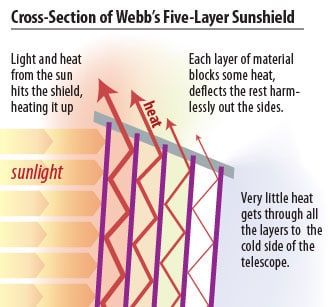

It’s time for the next – super exciting – step: unfolding the sun shield.
It’s been almost a week since the most powerful observatory ever built took to the skies. The James Webb telescope was origami folded to fit an Ariane-5 rocket. And now, as the telescope flies through the vast universe, it unfolds more and more parts. Today the most challenging element is on the agenda: it is time for the roll-out of the solar shield.
Rollout
In the past few days, however, some crosses have already been made. Yesterday, for example, James Webb stretched out all his “neck”. This created an opening, so that sufficient space has now been created for the sun shield to fully unfold. In addition, the covers that covered the folded sun shield were successfully removed yesterday.
It will also take some time before the sun shield is fully unfolded. That’s because the shield still needs to be pulled tight after it’s rolled out. And that takes some extra time. The sun shield was probably fully prepared on Sunday.
sun shield
It means that part of James Webb will never see direct sunlight again. Because the sun shield divides Webb into a ‘hot side’ and a ‘cold side’.
You’re hot and you’re cold… 🎵#NASAWebb is split into a “hot side” and “cold side” by its sunshield. The sunshield will always be facing the Sun to block out heat and light, as Webb’s mirrors need to stay extremely cold to observe faint heat signals in the universe! pic.twitter.com/GciNPo04nr
— NASA Webb Telescope (@NASAWebb) Dec 29, 2021
That’s really important. The James Webb telescope will primarily observe infrared light from faint and very distant objects. And in order to detect those weak signals, the telescope itself has to be extremely cold. That is why a 5-layer sun shield, the size of a tennis court, has been manufactured. This shield will protect the telescope from external light and heat sources (such as the sun, earth and moon) and from the heat radiated by the observatory itself. You can therefore compare this sun shield a bit with a parasol, which will always be directed towards the sun to repel heat and light.
The solar shield is being tested on Earth.
5-layer
You may wonder why the ingenious space telescope has a 5-layer sun shield instead of one thick one. That’s because each successive layer of the solar shield is cooler than the layer below it. The opening between the layers also provides an extra insulating effect. In short, one big thick solar shield conducts much more heat than a solar shield made up of five layers separated by vacuum.

Image: STScI
Material
The shiny silver material of the 5-layer sun shield is a complex and innovative piece of engineering. The lightweight shield is made of Kapton material, which has a high heat resistance. Each layer is also coated with aluminum and has a specific thickness and size. The hottest two layers of the side facing the sun also have a kind of silicon coating to reflect the heat from the sun back into space. The kite-like shape and the number of layers both play an important role. In this way, each individual layer is positioned with precision so that the telescope can do its job as well as possible.
The teething has begun. Because nothing should go wrong while rolling out the sun shield. The sun shield is really crucial for the functioning of the telescope. In any case, the team is well prepared. The steps have been extensively tested and practiced on earth. Yet it is exciting whether the roll-out of the solar shield in the universe, millions of kilometers away from Earth and without the possibility of intervention, will also go according to plan. To be continued…
Source material:
“Update: NASA Plans Coverage of Webb Space Telescope Deployments” – NASA
“ Webb Ready for Sunshield Deployment and Cooldown” – NASA
“About the sunshield” – NASA
“Webb Team Releases Sunshield Covers” – NASA
Image at the top of this article: NASA/Chris Gunn